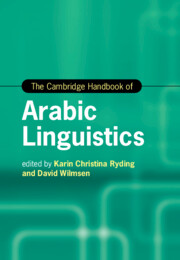Book contents
- The Cambridge Handbook of Arabic Linguistics
- Cambridge Handbooks in Language and Linguistics
- The Cambridge Handbook of Arabic Linguistics
- Copyright page
- Contents
- Figures
- Tables
- Notes on Contributors
- Acknowledgements
- Abbreviations
- Introduction
- Part I Arabic Applied Linguistics
- 1 Arabic Applied Linguistics
- 2 Language Planning in the Arab World in an Age of Anxiety
- 3 The Study of Arabic Language Acquisition
- 4 Issues in Arabic Language Testing and Assessment
- 5 Arabic Study Abroad
- 6 Models of Arabic Pronunciation
- Part II Arabic Variation and Sociolinguistics
- Part III Theoretical and Descriptive Studies
- Part IV Arabic Computational and Corpus Linguistics
- Part V Arabic Linguistics and New Media Studies
- Part VI Arabic Linguistics in Literature and Translation
- Index
- References
1 - Arabic Applied Linguistics
from Part I - Arabic Applied Linguistics
Published online by Cambridge University Press: 23 September 2021
- The Cambridge Handbook of Arabic Linguistics
- Cambridge Handbooks in Language and Linguistics
- The Cambridge Handbook of Arabic Linguistics
- Copyright page
- Contents
- Figures
- Tables
- Notes on Contributors
- Acknowledgements
- Abbreviations
- Introduction
- Part I Arabic Applied Linguistics
- 1 Arabic Applied Linguistics
- 2 Language Planning in the Arab World in an Age of Anxiety
- 3 The Study of Arabic Language Acquisition
- 4 Issues in Arabic Language Testing and Assessment
- 5 Arabic Study Abroad
- 6 Models of Arabic Pronunciation
- Part II Arabic Variation and Sociolinguistics
- Part III Theoretical and Descriptive Studies
- Part IV Arabic Computational and Corpus Linguistics
- Part V Arabic Linguistics and New Media Studies
- Part VI Arabic Linguistics in Literature and Translation
- Index
- References
Summary
This chapter provides an in-depth look at Arabic second language acquisition (SLA) by reviewing past and present approaches to teaching and how research into SLA has resulted in a number of hypotheses that relate directly to acquisition of Arabic as a second or foreign language. The account here is very rich in data that provide a substantive background for application and experimentation. A persistent challenge for Arabic is how to measure achievement and proficiency. Alhawary reviews Arabic testing strategies and how they fit into the overall picture of assessment. Blending the teaching of spoken and written Arabic has been a particular problem for the field, and Alhawary dedicates the last part of his chapter to evaluation of attempts to teach variation, underscoring the difficulties and challenges that face teachers, students, and materials developers.
Keywords
- Type
- Chapter
- Information
- The Cambridge Handbook of Arabic Linguistics , pp. 11 - 31Publisher: Cambridge University PressPrint publication year: 2021



